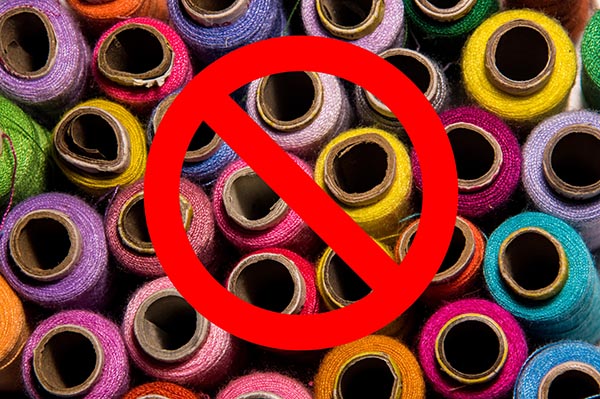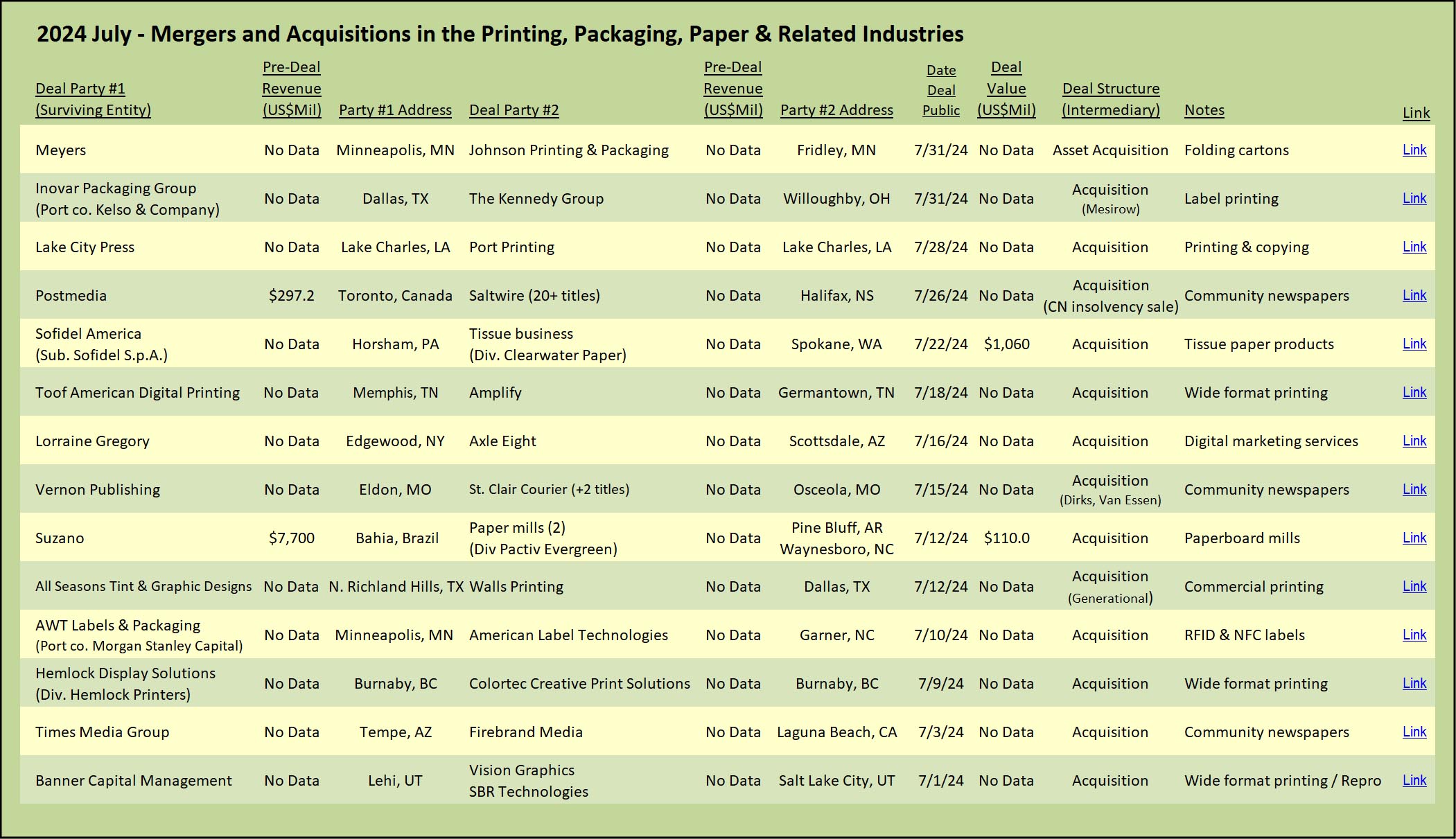
Two innovators in the design and manufacture of machines for the graphic arts industry recently filed for bankruptcy, highlighting how difficult it is to stay at the forefront with new ideas. One company pioneered a completely new method of dyeing yarn, made possible by digital printing technology. The other company gave up over a century of experience in the traditional business of making bookbinding machines to prepare for the possible future where content is completely digitized.
On-demand thread dyeing in demand
It all started with a simple idea: applying inkjet technology to yarn to create colors on demand.
The traditional method of sewing multi-colored embroidery designs onto promotional apparel is to change the thread spool several times or to use machines with multiple sewing heads, each using different colored threads.
If instead you could simply dye white thread in real time, inline, and to any color you wanted, you could sew a multi-colored logo without ever having to change threads. Swedish technology company Coloreel Group AB pioneered this idea, overcame all the challenges to perfect it, and introduced on-demand thread dyeing to the embroidery market. As the machine whirs, the thread changes color as required by the software-driven design built into the market-leading automatic embroidery machines. With Coloreel technology, colors from across the spectrum are available at all times. As an added bonus, gradual fades and color transitions that weren’t possible before are now possible.
It’s the embroidery equivalent of the plain paper workflow that has transformed the direct mail industry. Printers who have added branded embroidery to their advertising offering benefit from the flexibility offered by Coloreel technology. Each color logo is instantly produced using one color of in-stock thread: white.
Coloreel technology is considered a step forward in the search for sustainable solutions in the textile industry. It potentially eliminates the need to stock a variety of colors, reducing inventory, duplicate builds, obsolescence and waste. The heart of the system is an inkjet printer that is said to reduce water consumption by 97% compared to traditional dyeing methods.
The company was founded in Sweden in 2003 as a research company. It wasn’t until 2019 that the company announced its first marketable industrial application. In 2021, the company shifted its focus to manufacturing the machines to bring its technology to market, backed by an $8 million funding round from its existing and new investors. In September 2023, Coloreel announced that it had secured a $2 million investment from an unnamed Asian manufacturer to help meet increased demand for its yarn dyeing equipment.
Coloreel filed for bankruptcy on July 10. Reports do not indicate whether the company is attempting to reorganize, but the tone of the press release announcing the bankruptcy is funereal at best and, at least on the surface, offers no hope of the company’s resurrection. The company’s CEO announced the bankruptcy “with a heavy heart” and expressed regret that the company’s “tireless efforts” were not enough to keep the company afloat.
The bankruptcy filing comes as a sudden turn of events. It was only in May 2024 that Coloreel announced that it had reached an agreement to provide its technology to Japanese sewing machine manufacturer Juki. The venture was the first step in taking Coloreel beyond embroidery and into the much larger sewing market.
All the good news was not enough, even for a truly innovative company that owns over 120 patents in 45 markets. The company justified bankruptcy by its inability to grow its business fast enough to meet demand according to its financial model, insufficient financing and failure to minimize operating costs. At the time of writing, the Coloreel website is not working; the message displayed is “Payment required”.
After seeing this technology in action, we suspect this story is not over yet.
Your vacation may take longer than expected
Workers at the Kolbus plant in Rahden received the news during their company-wide summer vacation. The company, which develops and manufactures machines for finishing graphic products, announced that it was insolvent and had begun voluntary restructuring proceedings. For now at least, employees will return to work and receive their wages; under German insolvency law, salaries and wages will be guaranteed by a state agency for three months while the company plans and negotiates its restructuring plan. What happens after that is still unclear.
A trustee from Pluta, a European restructuring company, has been appointed to assist management in self-administering the restructuring plan (similar to a Chapter 11 restructuring in the US). The company has stated that business operations will continue as usual, and orders for new machines are being fulfilled, including those placed at the recent Drupa trade fair in Düsseldorf.
Today’s Kolbus headquarters and main office are located on the very same spot where Christian Henrich Kolbus laid the roots of the company that still bears his name in 1775. Young Kolbus had spent his early years shoeing horses for the Prussian army (Germany as a nation did not exist for nearly a hundred years yet). He settled in Rahden to open a blacksmith shop and farm for his family.
In 1877, Christian’s grandson Franz built a forge on the same site in what was then the German Empire. Franz started his business by manufacturing agricultural machinery, cast iron stoves, and components for church clocks and windmills. At this crucial turning point for the Kolbus family, Franz sent his son August to America, where he spent 13 years learning the bookbinding trade. With his extensive knowledge of the bookbinding trade, August returned to Rahden, where he designed and built a machine for rounding and pressing book spines. Affectionately named “Rupert,” the machine established Kolbus in the bookbinding equipment business, a path he followed until 2018 (except for the period during World War II, when the factory was converted to produce weapons for the German army and as a result was completely destroyed by the Allies).
After 243 years in business and well over a hundred years as a world-class manufacturer of bookbinding machines, Kolbus made a dramatic strategic U-turn in 2018 and withdrew from the majority of its bookbinding equipment business. In January of the same year, Kolbus sold its perfect binding and bookline business to the Swiss-based company Müller Martini. To preserve the comprehensive know-how of the Kolbus book business, around 250 employees were transferred to the Müller Martini business unit, which then built a separate factory in Rahden.
At the time, the long-term book business seemed to be in steady decline and demand for packaging was increasing. Kolbus then executed the next step in its strategic plan and acquired British machinery manufacturer AutoBox in September 2018. Kolbus drove its new strategic direction and introduced a highly automated modular flexo printing and die-cutting machine that produces corrugated boxes printed on one or both sides in a single pass. Other machines produce a variety of box types, including automated production of packaged rigid boxes.
Kolbus is now almost exclusively active in the packaging machinery business. After almost 250 years, the company has mastered the transition from a simple forge to a manufacturer of highly sophisticated machines, rebuilt itself after total destruction in the war and built a highly respected brand at a world level.
Despite the recent financial challenges that led to the bankruptcy filing, Kolbus’ story is not over yet. Given its long history, we believe it is premature to prejudge the long-term correctness of Kobus’s move from book manufacturing to the packaging industry. If the company can restructure itself in a way that allows it to survive in the short term, it could prove as prescient as its move from making wood-burning ovens to making bookbinding equipment over a century ago.



View the Target Report online, complete with deal transcripts and source links for July 2024
www.graphicartsadvisors.com
